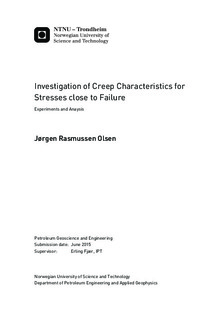| dc.description.abstract | This study consists of a series of experiments set up to investigate the active processes in creep, with emphasizes on unloading and recovery of strain. The experiments were performed on dry 1x2 inch cylindrical core samples of Castlegate, tested with a uniaxial electromechanical load frame. The strain was measured using high precision displacement sensors (LVDTs) and strain gauges, while recording acoustic P-wave velocities and monitoring the temperature. Each test have been performed over a period of 20-24 hours, with incremental changes in stress, both loading, unloading and reloading, with hold periods of 2-4 hours. The stress is typically increased to a state near failure in the beginning of the experiment, before it is decreased in increments toward the end. The series of experiments resulted in 5 high quality data sets.
Existing models have been used in attempts to reproduce the measured data from the experiments. The Burger s model was able to reproduce the measured data to high precision, given a sufficient number of free variables. However using only one set of parameters the model could only reproduce the first increase in stress, leaving the remainder of the interval far off the measured data. The parameters obtained when fitting the data was deviating between each sample, especially the viscosity based parameters. The elastic parameters were also found to decrease for each drop in stress, meaning that the instant elastic recovery increased. The FORMEL model was fitted using three free variables, less than the Burger s model, however the interval which was possible to predict was smaller. The FORMEL model is still unable to predict strain recovery.
Further experiments were compared to each other in the search for repeating trends. It was found that the P-wave velocity increased during hold periods with constant stress following a decrease in stress. This observation coincides with existing knowledge of hold periods following increases in stress, where the P-wave velocity decreases. Another interesting observation during reloading showed P-wave velocities increased during hold periods following reloading to previously held stress levels. | |

